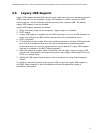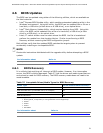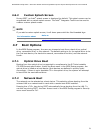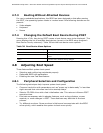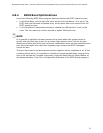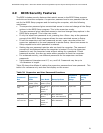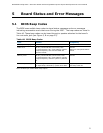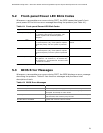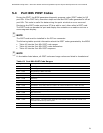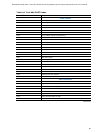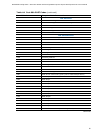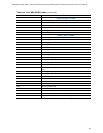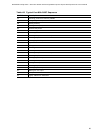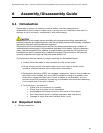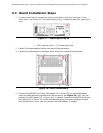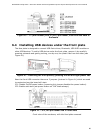
Embedded Intel® Atom Processor D2700 with Intel® NM10 Express Chipset
79
5.4 Port 80h POST Codes
During the POST, the BIOS generates diagnostic progress codes (POST codes) to I/O
port 80h. If the POST fails, execution stops and the last POST code generated is left at
port 80h. This code is useful for determining the point at which an error occurred.
Displaying the POST codes requires a PCI bus add-in card, often called a POST card.
The POST card can decode the port and display the contents on a medium such as a
seven-segment display.
NOTE
The POST card must be installed in the PCI bus connector.
The following tables provide information about the POST codes generated by the BIOS:
Table 43 lists the Port 80h POST code ranges
Table 44 lists the Port 80h POST codes themselves
Table 45 lists the Port 80h POST sequence
NOTE
In the tables listed above, all POST codes and range values are listed in hexadecimal.
Table 43. Port 80h POST Code Ranges
Range
Subsystem
0x00 0x05
Entering SX states S0 to S5.
0x10, 0x20, 0x30
Resuming from SX states (0x10 0x20 S2, 0x30 S3, etc.)
0x11 0x1F
PEI phase pre MRC execution
0x21 0x29
MRC memory detection
0x2A 0x2F
PEI phase post MRC execution
0x31 0x35
Recovery
0x36 0x3F
Platform DXE driver
0x41 0x4F
CPU Initialization (PEI, DXE, SMM)
0x50 0x5F
I/O Buses: PCI, USB, ATA etc. 0x5F is an unrecoverable error. Start with PCI.
0x60 0x6F
BDS
0x70 0x7F
Output devices: All output consoles.
0x80 0x8F
For future use
0x90 0x9F
Input devices: Keyboard/Mouse.
0xA0 0xAF
For future use
0xB0 0xBF
Boot Devices: Includes fixed media and removable media. Not that critical since
consoles should be up at this point.
0xC0 0xCF
For future use
0xD0 0xDF
For future use



